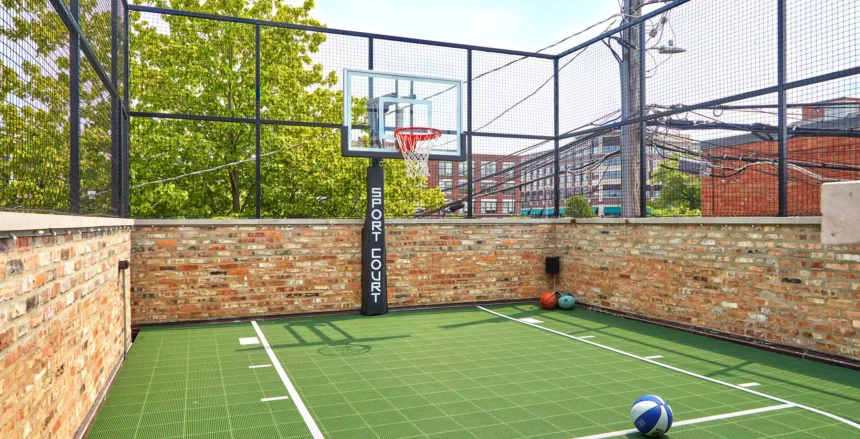As the popularity of recreational sports continues to grow, homeowners, schools, and community organizations are increasingly looking for effective ways to enhance their indoor and outdoor spaces. One of the most compelling solutions is the installation of a sport court for decking. These modular flooring systems offer a durable and versatile surface that accommodates various sports and recreational activities. In this article, we will delve into the ten key benefits of sport courts for decking, exploring how they can transform your recreational spaces while emphasizing their importance in promoting active lifestyles.
1. Versatility in Sports Applications
One of the standout features of a sport court for decking is its remarkable versatility. Unlike traditional sports surfaces that cater to specific activities, sport courts can be customized for a wide array of sports, making them ideal for multi-sport facilities, schools, and homes. Whether you’re interested in basketball, tennis, volleyball, or even inline hockey, a sport court can be tailored to meet your specific needs.
Multi-Sport Facilities
In community centers or schools where space is limited, a sport court for decking can maximize utility. For instance, a single court can serve as a basketball court during the winter months, then be easily converted into a volleyball court for summer camps. This flexibility allows facilities to offer diverse programs without the need for multiple surfaces, thereby reducing costs and increasing participation.
Family-Friendly Recreation
For families, having a sport court at home opens up a world of recreational possibilities. Parents can engage their children in various activities, from basketball games to skateboarding, all in one place. This encourages a healthy, active lifestyle, promoting physical fitness and family bonding.
2. Easy Installation Process
The installation of a sport court for decking is not only efficient but also straightforward. Many sport courts consist of interlocking tiles that can be easily laid over existing surfaces like concrete, asphalt, or even grass. This means that homeowners and facility managers do not need to undertake extensive site preparation or demolish existing structures to create a new sports area.
DIY Installation Options
Many manufacturers offer DIY kits that allow homeowners to install their sport courts with minimal professional help. These kits typically come with detailed instructions and all necessary components, making it an achievable project for those with basic handyman skills. This cost-effective approach can significantly reduce installation costs and time, allowing you to enjoy your new sports area sooner.
Temporary and Permanent Solutions
For those who may not want a permanent installation, sport courts can also be set up temporarily. Whether for a special event, community tournament, or seasonal use, these courts can be assembled and disassembled as needed, offering flexibility and adaptability for various occasions.
3. Durable and Weather-Resistant Materials
Durability is a critical factor when considering a sports surface, and sport courts excel in this regard. Made primarily from high-density polyethylene (HDPE) or similar synthetic materials, these courts are designed to withstand the elements. They can resist fading due to UV exposure, wear and tear from foot traffic, and impact from various weather conditions, ensuring longevity and performance.
Impact Resistance
Sport courts are engineered to absorb shocks and reduce the risk of damage from heavy impacts, such as a basketball hitting the surface during play. This resilience makes them suitable for high-intensity sports, providing athletes with a safe environment to perform at their best.
Weather Performance
Many sport courts feature a non-slip surface that remains functional even when wet, allowing for continuous play regardless of weather conditions. This feature is particularly beneficial in areas with variable climates, as it ensures that users can engage in sports without worrying about safety hazards.
4. Low Maintenance Requirements
One of the most appealing aspects of a sport court for decking is its low maintenance requirements. Traditional sports surfaces, such as grass or wood, often require regular upkeep, including mowing, sealing, and resurfacing. In contrast, sport courts are designed to be user-friendly and require minimal effort to maintain.
Simple Cleaning Procedures
Maintaining a sport court typically involves regular cleaning with soap and water or a mild detergent. Occasional power washing can remove debris and dirt buildup, ensuring a clean and safe playing surface. Unlike wood surfaces, which may require refinishing or sealing, sport courts remain functional without these additional processes.
Durability Leads to Longevity
The durable materials used in sport courts ensure that they resist stains, odors, and fading, reducing the need for frequent replacements or repairs. With proper care, a sport court can last for years, providing a reliable surface for athletes and recreational users.
5. Enhanced Safety Features
Safety is paramount in any recreational setting, and sport courts are designed with this in mind. The non-slip surfaces provide excellent traction, reducing the likelihood of falls and injuries. Additionally, many sport courts have shock-absorbing properties that help to lessen the impact on joints during play.
Injury Prevention
The cushioned surface of a sport court can significantly reduce the risk of injuries related to slips and falls, making it an ideal choice for children and seniors. The added comfort encourages users of all ages to participate in physical activities, promoting a healthier lifestyle.
Compliance with Safety Standards
Most sport courts adhere to established safety standards set forth by organizations such as the International Basketball Federation (FIBA) and the American Sports Builders Association (ASBA). These guidelines ensure that the courts provide a safe environment for athletes, thereby enhancing their appeal for schools and community centers.
6. Aesthetic Appeal
Beyond functionality, a sport court for decking adds significant aesthetic value to any property. Available in a wide variety of colors and designs, these courts can be customized to match your home’s exterior or the branding of a facility. The bright colors and professional look can transform a dull outdoor space into an attractive recreational area.
Customization Options
Many manufacturers offer options for customization, allowing you to choose colors, logos, and even patterns that reflect your personality or community spirit. This customization ensures that your sport court not only serves its functional purpose but also enhances the overall appeal of your property.
Visual Impact
A well-designed sport court can become a focal point in your yard or community space, attracting attention and encouraging participation in recreational activities. The vibrant colors and professional appearance can inspire both youth and adults to engage in sports and physical fitness.
7. Cost-Effective Solution
While the initial investment in a sport court for decking may seem higher than traditional flooring options, the long-term savings can be significant. The durability and low maintenance requirements mean fewer replacements and repairs, making sport courts a cost-effective solution for sports and recreation.
Long-Term Savings
When you consider the costs associated with maintaining traditional surfaces—such as grass or wood—the benefits of a sport court become even more apparent. With less frequent maintenance and the ability to host multiple activities, the overall cost of ownership can be lower over time.
Increased Usage
By providing a dedicated and attractive space for sports, sport courts encourage more people to engage in physical activities. Increased usage can lead to healthier communities and a greater return on investment for facilities that cater to sports and recreation.
8. Environmentally Friendly Options
In an age where sustainability is more important than ever, many manufacturers of sport courts prioritize eco-friendly materials and production methods. Some sport courts are made from recycled materials, and their longevity reduces the need for frequent replacements, further minimizing environmental impact.
Recycled Materials
Many sport courts incorporate recycled plastics, making them a sustainable choice for environmentally conscious consumers. By opting for a sport court, you contribute to a circular economy and help reduce plastic waste.
Reduced Carbon Footprint
The durability of sport courts means they do not require frequent replacement, which reduces the carbon footprint associated with manufacturing, transportation, and disposal of traditional surfaces. Choosing a sport court aligns with sustainable practices and encourages a commitment to environmental responsibility.
9. Increased Property Value
Installing a sport court can significantly enhance your property value. A well-designed recreational area is appealing to potential buyers, especially families looking for homes with outdoor amenities. The presence of a sport court can set your property apart in a competitive real estate market.
Attractive Amenities
Real estate trends show that homes with recreational facilities, such as sport courts, often sell faster and at higher prices. These amenities are especially attractive to families with children, making your property more desirable to a wider audience.
Market Demand
As more people prioritize health and wellness, the demand for homes with recreational features is likely to grow. Installing a sport court can be a strategic investment that pays off in the long run, whether you plan to stay in your home for years or eventually sell it.
10. Promotes Physical Activity and Community Engagement
One of the most significant benefits of installing a sport court for decking is the promotion of physical activity and community engagement. By providing a dedicated space for sports, you encourage family members and neighbors to get active, build relationships, and foster a sense of community.
Encouraging Active Lifestyles
Having a sport court readily available makes it easier for families to engage in physical activities. Whether it’s a game of basketball after dinner or a weekend volleyball tournament, these courts provide an accessible way to stay fit and active.
Community Events and Tournaments
Sport courts can also serve as a venue for community events, such as tournaments, clinics, or family fun days. These gatherings promote social interaction and help build a sense of belonging among community members. By bringing people together, sport courts can play a crucial role in strengthening community bonds.
How to Add a Sport Court to a Deck for Basketball
Adding a sport court for decking specifically for basketball can transform your deck into a versatile recreational area. Here’s a step-by-step guide on how to do this effectively:
1. Assess Your Space
Before making any purchases, it’s crucial to evaluate your deck’s size and condition. Measure the available area to determine how large you want your basketball court to be. The official size for a half-court basketball court is 42 feet by 50 feet, but you can adjust the dimensions based on your available space.
2. Choose the Right Sport Court Tiles
Select high-quality sport court tiles designed specifically for basketball. Look for options made from durable materials like high-density polyethylene (HDPE), which can withstand the elements and heavy foot traffic. Consider the following features:
Shock Absorption: Choose tiles with good cushioning to reduce the impact on joints while playing.
Traction: Non-slip surfaces are essential for safety, especially in wet conditions.
Color Options: Opt for colors that align with your aesthetic preferences or match the overall design of your home.
3. Prepare the Deck Surface
Ensure that the deck surface is clean, dry, and level. If there are any damages, such as cracks or uneven areas, repair these before installation. A solid and stable foundation is essential to support the sport court tiles effectively.
4. Install the Sport Court Tiles
Most sport court tiles come with an interlocking design, making installation straightforward. Here’s how to proceed:
Lay the First Tile: Start in a corner of your deck and lay down the first tile.
Interlock the Tiles: Continue laying the tiles, interlocking them according to the manufacturer’s instructions. Use a rubber mallet to ensure a secure fit without damaging the tiles.
Create the Court Dimensions: Ensure the layout matches your desired basketball court dimensions, including space for the free-throw line, three-point line, and other markings as needed.
5. Add Court Markings
Once the tiles are installed, consider adding court markings. You can use tape or paint designed for outdoor sports surfaces. Be sure to include the following:
Free-Throw Line: Typically 15 feet from the basket.
Three-Point Line: The distance may vary based on your preference, but it’s usually around 19.75 feet for NBA and 22.15 feet for FIBA.
6. Install Basketball Equipment
Select and install basketball equipment suitable for your deck. You can choose a portable hoop or a permanent installation, depending on your preferences:
Portable Hoops: These can be moved easily and adjusted for different heights, making them ideal for families with children.
In-Ground Hoops: If you’re looking for a more permanent solution, consider installing an in-ground basketball hoop. Ensure it’s securely anchored and meets height regulations (typically 10 feet for official play).
7. Regular Maintenance
To keep your sport court for decking in optimal condition, perform regular maintenance. This includes cleaning the surface to remove dirt and debris, inspecting for damage, and ensuring that the tiles are securely locked together.
Sport Decks for Outdoor Basketball Courts
Sport decks designed specifically for outdoor basketball courts are an excellent investment for residential properties, schools, and community facilities. Here’s a detailed overview of what you should consider when exploring sport decks for outdoor basketball courts.
1. Benefits of Using Sport Decks
Durability: Outdoor sport decks are engineered to withstand weather conditions, including UV exposure and temperature fluctuations, ensuring a long lifespan.
Low Maintenance: Compared to traditional surfaces, sport decks require minimal upkeep, saving you time and effort in maintaining your outdoor space.
Safety Features: Many sport decks have shock-absorbing properties that reduce the risk of injury, making them ideal for high-impact sports like basketball.
Versatility: A sport court for decking can accommodate not only basketball but also other sports, allowing you to utilize the space for various activities.
2. Choosing the Right Material
When selecting a sport deck for outdoor basketball courts, consider the following materials:
Polypropylene Tiles: These are popular due to their durability, non-slip surfaces, and resistance to fading. They are easy to install and can be customized with various colors and patterns.
Rubber Surfaces: Rubber is another option that provides excellent shock absorption and traction, making it suitable for outdoor sports. It’s also resistant to weather conditions.
3. Installation Considerations
Surface Preparation: Ensure that the area where the sport deck will be installed is level and stable. You may need to add a base layer of gravel or sand for drainage.
Drainage: Proper drainage is crucial for outdoor basketball courts to prevent water accumulation, which can damage the surface and create hazards. Ensure the area slopes away from the court for effective water runoff.
4. Customization Options
Sport decks can be customized in various ways to meet your needs:
Color and Design: Choose colors that align with your personal or organizational branding. Many manufacturers offer customizable designs and logos.
Court Markings: Custom court markings can be added to suit your needs, whether for recreational play or official competition.
5. Community Engagement
Installing a sport deck for an outdoor basketball court can foster community engagement. It creates a gathering space for residents, encouraging physical activity and social interaction. Hosting tournaments, clinics, or community events can further enhance the sense of community.
6. Cost Considerations
While the initial investment in a sport court for decking may seem significant, the long-term benefits can outweigh the costs. Factors that can affect pricing include:
Size of the Court: Larger courts will naturally cost more to install.
Material Choice: Different materials come at various price points, so choose one that fits your budget and needs.
Installation: If you’re hiring professionals for installation, factor in labor costs.
Building Community and Promoting Fitness
Incorporating a sport court for decking specifically designed for basketball into your home or community space can greatly enhance recreational opportunities. By following the outlined steps for adding a sport court to a deck and considering the benefits of sport decks for outdoor basketball courts, you can create a functional and attractive space that promotes physical activity and community engagement.
Whether you’re a homeowner looking to increase your property’s value or a community organizer aiming to foster a healthy environment, a sport court can be a transformative addition that delivers long-lasting benefits.
FAQ Section
What types of sports can be played on a sport court for decking?
A sport court for decking can accommodate a wide range of sports, including basketball, tennis, volleyball, badminton, and even multi-sport activities. Custom markings can be applied to suit specific games.
How long does it take to install a sport court?
The installation time for a sport court can vary based on the size and complexity of the design. However, most installations can be completed within a few days, particularly with DIY kits that simplify the process.
Are sport courts safe for children?
Yes, sport courts are designed with safety in mind. They feature non-slip surfaces and cushioning to help prevent injuries from falls or slips, making them safe for children and adults alike.
Can I install a sport court on uneven surfaces?
While sport courts can be installed over various surfaces, it’s best to ensure the base is relatively level. Uneven surfaces may require additional preparation, such as filling in low spots, to ensure a smooth playing area.
How do I maintain my sport court for decking?
Maintaining a sport court is straightforward and involves regular cleaning with soap and water, inspecting for damages, and ensuring proper drainage to avoid water accumulation. Unlike traditional surfaces, sport courts do not require sealing or refinishing.
What is the lifespan of a sport court?
The lifespan of a sport court can vary depending on usage, weather conditions, and maintenance. Generally, with proper care, sport courts can last anywhere from 10 to 20 years or more.
Are sport courts environmentally friendly?
Many sport courts are made from eco-friendly materials, and their durability reduces the need for replacements, making them a sustainable choice for recreational areas.
Can sport courts be customized?
Absolutely! Sport courts can be customized in terms of color, design, and markings to suit individual preferences or branding needs, making them an attractive addition to any property.
How much does a sport court for decking cost?
The cost of a sport court can vary widely based on size, material, and customization options. On average, you might expect to invest between $5,000 and $20,000, depending on your specific requirements. It’s always best to get quotes from multiple suppliers to compare options.
Can I get a sport court that caters to multiple sports?
Yes! Many sport courts are designed to be multi-functional, allowing you to play various sports on the same surface. You can work with manufacturers to customize your court to include markings for multiple sports.
Conclusion
The installation of a sport court for decking presents numerous advantages that extend beyond just providing a surface for sports. From versatility and durability to enhanced safety and aesthetic appeal, sport courts are a worthwhile investment for any residential or commercial space. They not only promote an active lifestyle but also foster community connections, making them a valuable addition to neighborhoods, schools, and recreational facilities.
If you’re considering enhancing your outdoor or indoor space, a sport court could be the perfect solution. By understanding the key benefits outlined in this article, you can make an informed decision and enjoy the many rewards that come with having a dedicated space for sports and recreation. As our communities become increasingly focused on health and wellness, the importance of accessible and engaging recreational spaces cannot be overstated. With a sport court, you’re not just investing in a surface—you’re investing in a healthier, happier community.








